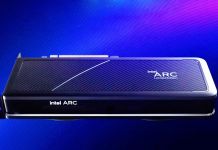After a few flaws in our review of Gainward’s GeForce FX 5800 Ultra we thought that they deserve a second chance now when the Detonator FX is released. This short article can be seen as a little review of the Detonator FX and an update of our Gainward FX 5800 Ultra review.
After a few
flaws in
our review of Gainward’s GeForce FX 5800 Ultra we thought that they
deserve a second chance now when the Detonator FX is released. This short
article can be seen as a little review of the Detonator FX and an update of
our Gainward FX 8500 Ultra review.
We had six major
problems with Gainwards card when we reviewed it. The noise, the price, the
availability, the performance, the image quality and the lack of overclocking.
New drivers can of course not fix the noise, price nor availabilities but
it should fix the three other things.
We will first
begin to look at how the standard image quality has changed when we compare
Detonator 40 (43.45) against Detonator FX (44.03).
And we have the
image quality. We discovered in our first look at GeForce FX that the card
with its default settings had much worse texture filtering than older GeForce
and Radeon cards. We will first test the common trilinear filtering. This type
of texture filtering is being used by almost every game which has been
released the past few years as a standard. Therefore it is important that the
image quality here is high. To make a long story short: the images below with
the grid should be interpreted in the following way: More white/black (or less
colors if you turn it around) = good. Soft nice crossings between the
different colors = good.
|
|
|
The image
quality is almost identic on ATi’s and nVidia’s cards with the new Detonator
FX. Admittedly the 43.45 looks a bit worse than 44.03 but it’s nothing
you would cry over when it looks like this.
Shall we take a look and see if the new improvements also applies to
antistrophic filtering?
|
GeForce
FX 5800 Ultra (8x Aniso) |
Radeon
9700 Pro (16x Aniso) |
Yup, nVidia
is now on the same level as ATi. ATi has in the images above a small
advantage due to its higher max level of Aniso. Here you can further see
that the older driver 43.45 has inferior image quality.
|
GeForce
FX 5800 Ultra (8x Aniso) |
Radeon
9700 Pro (16x Aniso) |
If we look at
our image taken in a tunnel, we can see how biased textures affect the
filtering. It is very clear here that nVidia does a much better job than ATi
under these circumstances. It is very obvious how much better the quality is
in 44.03. You can shortly say that the less "colorful" areas there are in the
image the higher the quality is here.
While we are
looking onto image quality we thought we would give you a picture of how the
image quality has changed since GeForce4 Ti.
|
GeForce
FX 5800 Ultra (8x Aniso) |
GeForce4
Ti4600 (8x Aniso) |
|
|
|
As we mentioned
earlier, the GeForce FX series has now equal good texture filtering as its
older brothers in the GeForce4 series. It’s about time.
We can not see
any changes in Detonator FX when it comes to FSAA. The lower image quality
(compared to ATi that is) simply depends on limitations in nVidia’s hardware.
I still have a hard time understanding that nVidia bought 3dfx, the king of
FSAA, and later not used their most famous technology.
Then it is time
for me present the probably most interesting thing by you readers, the
performance.
When using the
setting "Application", which was the only setting that had the image
quality corresponding to ATI’s products and older GeForce cards, the performance
of the GeForce FX 5800 Ultra was very bad. It was specially obvious in Unreal
Tournament 2003. Shall we take a look and see how nVidia has behaved?
We have chosen
to test Quake 3 and UT2003. In the two games we run with FSAA and Aniso
activated because this is were the GeForce FX had problems.
|
|
As we can
see there are no major problems with the performance when we run at 2x
FSAA and 4x Aniso in Quake 3. This is approved no matter what driver we
chose. However it becomes obvious that nVidia has managed to improve the
performance quite a bit at 1600×1200. Radeon 9800 Pro must see itself
beaten, though not by a large margin.
Though, 2x
FSAA and 4x Aniso is a little "wimpy" for graphic cards in this price
range. 4x FSAA and 8x Aniso is much more interesting.
|
|
We can see
here that it doesn’t look so good for the Gainward FX. The card is beaten
much more here than the Radeon when we ran 2xAA/4xAF. Here we simply deal
with one of the 5800’s hardware limitations: memory bandwidth. 1 GHz DDR-II
doesn’t mean much if the memory bus still is only 128 bit wide.
The Radeon
cards had a much greater advantage in UT2003 last time. It will be very
interesting to see what Detonator FX can do about it.
|
|
Admittedly the
Radeon 9800 Pro is still the fastest in all tests with 2x AA and 4x AF but
look at the peerless boost FX gets with Detonator FX. Over 100% improvement
in all the tests. Here it is no longer a matter of regular outclassing.
Instead 5800 Ultra and 9800 Pro has almost equal performance in the two lower
resolutions. 1 fps is hardly anything to consider in this coherence.
|
|
ATi’s giant
gets a little bigger advantage with 4x FSAA and
8x Aniso but FX 5800 Ultra is not far behind. Detonator FX can even here
brag with a 100 percent improvement in all tests.
One thing
though that still is approving is that nVidia’s 4x FSAA does not contain the
same high quality as ATi’s. You should also take this in consideration when
you look at the diagrams. We can on the images below see that ATi has a clear
advantage when it comes to antialiasing. Simply the less "angular" edges the
better.
|
|
|
Further nVidia
has nothing that can compete with ATi’s 6x FSAA. The settings that nVidia can
offer over 4x FSAA has worthless performance in the majority of situations you
can think of despite the new Detonator FX. These settings will be available in
Direct3D:
|
|
We have less
options in Open GL. We can also mention that nVidia has removed 16x FSAA out
of Detonator FX. It hardly feels like a loss considering the performance.

|
Better image
quality and performance, not bad. The modified conclusion is to be found on
the next page.
How did the
overclocking go this time? Well, hardly better than the last time. This time
it seemed like we managed to clock the memory, but the results we got were
everything but normal. The core was also overclockable but in 50% of the tests
we ran it gave negative performance instead of positive. Very strange, and
what we get of this is that Gainward’s 5800 Ultra is not the card for you who
wish to overclock.
Perhaps we must reserve ourselves from errors on our page here, but it seems
pretty strange because overclocking a graphic card hardly means anything more
than pulling a little gauge in a program.
How does Detonator
FX affect our view of Gainward’s GeForce FX then? Unfortunaley two of the
"nailbits" are still in our eye: the price and noise. The performance
has gotten a whole lot better, so that grade has improved, same thing with
the image quality. GeForce FX 5800 Ultra has admittedly some performance benefits,
mainly with low levels of FSAA and Aniso but when its competitors handles
4x FSAA and 8x Aniso easily it doesn’t feel like it is much to come with.
The problem is that the card has too little memory bandwidth, nVidia and Gainward
have a cure to this. It is called GeForce FX 5900 Ultra. In other words it
is not anything drivers can fix.
|
Gainward
GeForce FX 5800 Ultra:  |
|
|
Accessories/Features: | 9.5 |
| Price/Availability: | 4.5 |
| Design/Cooling: | 3.5
|
Image quality: | 8.5 |
Performance: | 8.0 |
|
Overclocking: | – |
Final mark: |
6.8
|
The earlier
final mark was 6.2. It is now raised to 6.8 thanks to Detonator FX. This
product is, despite its great improvements with the new drivers, nothing we
recommend. The noise, lack of overclocking, price and availability speaks
their language here.
My recommendation is to buy a Radeon 9800 Pro today or wait for GeForce FX
5900 Ultra. There are more surprises on the graphics card front soon for you
who can wait longer…
When it comes
to Detonator FX we can only say thumbs up. If only nVidia can explain the very
strange results in 3DMark03 which Extreme Tech, Futuremark
and Beyond3D has reported we would be even more pleased.












.jpg)
.jpg)
.jpg)
.jpg)
.jpg)
.jpg)
.jpg)
.jpg)
.jpg)
.jpg)








